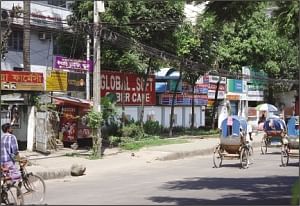All about a broken promise

Shops and business establishments are common features of the Dhanmondi residential area nowadays.Photo: STAR
Once an idyllic residential area, Dhanmondi today is almost devoid of gardens, green lawns and big trees with the onslaught of reckless commercialisation and changes in land use pattern.
Rajdhani Unnayan Kartripakkha (Rajuk) has allowed commercialisation of Dhanmondi without any consultation with locals violating the terms and conditions in the lease deeds of their plots.
Dhanmondi roads no 2, 27 and Satmasjid Road were not meant for commercial purposes in the original plan, but now they are all heavily commercialised.
The inevitable consequence is today's woes and predicament of the residents who chose the area to live with an aspiration of a serene residential atmosphere.
Deafening noise generated from commercial set-ups, unbearable traffic snarl-ups and excessive heat have made life miserable and destroyed serenity of the area.
Prof Muzaffer Ahmad, one of the oldest Dhanmondi residents at Satmasjid Road, said every house in the area once used to have a garden and green lawn. There were many old trees by the roadside and on every house premises, which are no longer there today.
Prof Serajul Islam Chowdhury, another resident, said, “Trees in the Dhanmondi residential area have been the first victims to apartment culture.”
“A rural set-up was incorporated in this urban residential area and many original plot-owners hailing from villages would feel at home here,” said Prof Ahmad, an environmentalist.
Commercial and non-residential establishments including private offices, shops, restaurants, private universities, hospitals, clinics, diagnostic centres, shopping malls and factories have mushroomed in the area over the years occupying residential buildings.
In 1950s the then Construction and Building (C&B) Department set up the residential area with only 882 plots. The number increased by at least 20 times in the last five decades, said locals.
Initially, a one-bigha plot was allotted for one family. Gradually the authorities allowed 2-stoery, 6-storey and finally high-rise apartments as well as commersialisation of certain roads and areas.
According to the original master plan, none of the houses could go above two-storey and the rule was in force until 1980, when deviations in different forms started following Rajuk's involvement in building approval, said Prof Ahmad.
Rajuk relaxed the height restriction and started allowing 6-storey buildings in place of 2-storey. Most of the large plots have ever since been divided and divided again not only to accommodate multi-storey and high-rise apartments but also for commercial use.
According to a survey carried out in 2001 by Maqshud Hasan of Urban and Regional Planning department of Buet, non residential uses in Dhanmondi residential area were 28 percent in 1984, 35 percent in 1993 and it increased to 50 percent by the year 2000.
“Once our house was so airy and full of sunlight that we did not have to turn the lights and fans on during daytime,” said Ahmad. “But hot air from air-conditioners and electricity generators at a shopping complex just beside my house has made a sound living impossible.”
The role of DCC is also dubious in this regard. It is the duty of DCC to check the business establishments at residential buildings before issuing trade licence.
There were no provisions for markets and shopping malls in the residential area in the master plan of Dhanmondi as New Market, Rayerbazar, Hazaribagh and Mohammadpur markets surround the vast residential area.
Moreover, three major open spaces in Dhanmondi have been exclusively occupied by clubs and sports organisations depriving the locals of breathing space.
Dhanmondi Lake used to flow into the river Buriganga through creeks and ponds in Pilkhana, where headquarters of Bangladesh Rifles has been set up.
Prof Chowdhury said, “Residential character is no longer there in the area. Commercialisation has been going on with indulgence of the authorities and desire of the residents.”
Once there was no traffic congestion in the area. Now it is one of the heavily congested areas.
Dhanmondi is the first planned residential area after partition of British India in 1947, where the authorities have allowed commercialisation in violation of building code, environmental and urban planning rules, said Salma Shafi, an urban planner and resident at road no 6.
Today, life in the area is miserable with noise pollution, high temperature, traffic congestion, unruly honking of the vehicles and lack of open air, she said.
Had the Detailed Area Plan (DAP) for Dhaka city been framed properly even five years earlier, much of the residential environment of Dhanmondi and Gulshan could be saved.
Abdullah-Al-Safi, chief engineer of Public Works Department (PWD), said that spoiling character of a designated residential area is not acceptable.
“Rajuk is answerable as to why they endorsed commercial and non-residential uses in deviation to the area's original plan,” he said.
But he agreed that PWD on the other hand did not take any action to stop such deviations to the original plan. “It is evident nothing was done.”
Rajuk Chairman Md Shafiqul Islam said, “I cannot make detailed response to the issue as I have just taken over my new position.”

 For all latest news, follow The Daily Star's Google News channel.
For all latest news, follow The Daily Star's Google News channel. 




Comments